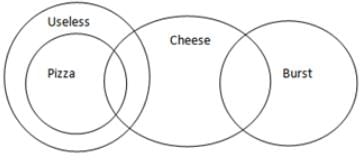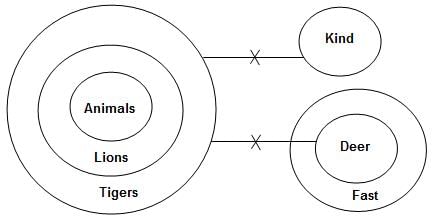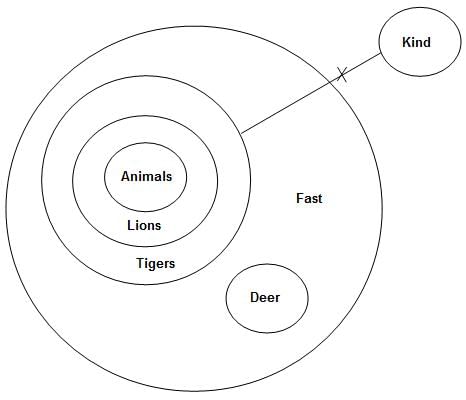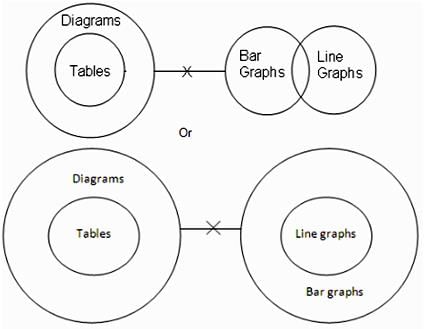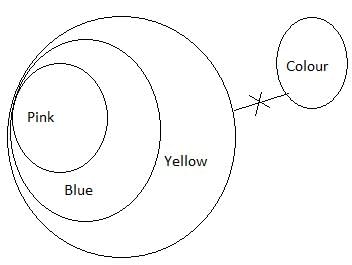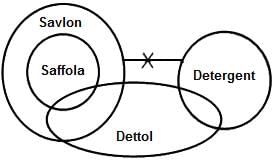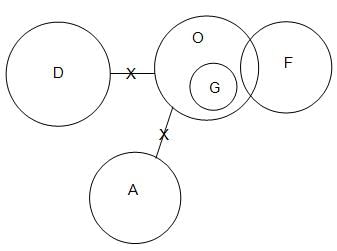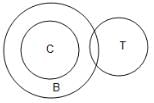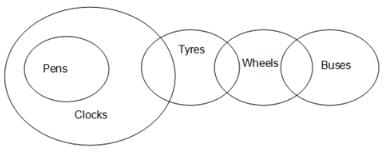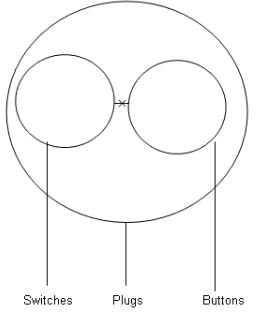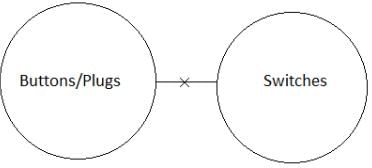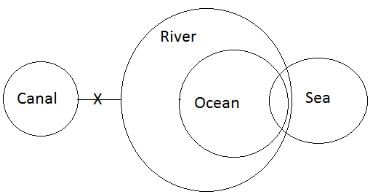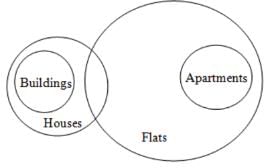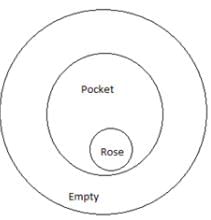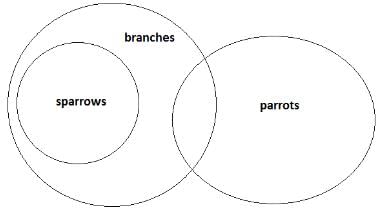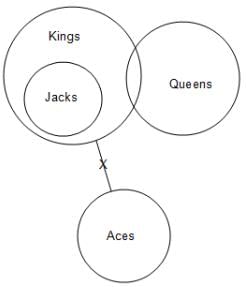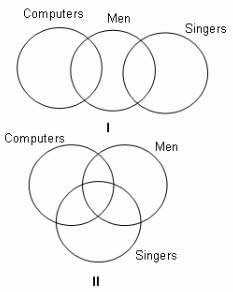Test Level 1: Syllogism - 2 - CAT MCQ
20 Questions MCQ Test Level-wise Tests for CAT - Test Level 1: Syllogism - 2
Directions: In the question below, three statements are given, followed by three conclusions numbered I, II and III. You have to take the given statements to be true even if they seem to be at variance with commonly known facts. Read all the conclusions and then decide which of them logically follows from the given statements, disregarding commonly known facts.
Statements:
Some cheese is burst.
No burst is pizza.
All pizzas are useless.
Conclusions:
I. No cheese is pizza.
II. Some burst is useless.
III. Some pizzas are cheese.
Some cheese is burst.
No burst is pizza.
All pizzas are useless.
Conclusions:
I. No cheese is pizza.
II. Some burst is useless.
III. Some pizzas are cheese.
Directions: The question below consists of four statements followed by three conclusions numbered I, II and III. You have to take the given statements to be true even if they seem to be at variance from commonly known facts. Read all the statements and then decide which of the given conclusions logically follow(s) from the given statements, disregarding commonly known facts.
Statements:
All spoons are bowls.
All bowls are pans.
All pans are sticks.
All sticks are knives.
Conclusions:
I. Some knives are pans.
II. Some sticks are bowls.
III. Some pans are spoons.
All spoons are bowls.
All bowls are pans.
All pans are sticks.
All sticks are knives.
Conclusions:
I. Some knives are pans.
II. Some sticks are bowls.
III. Some pans are spoons.
Directions: This question consists of three statements followed by four conclusions marked I, II, III and IV. Consider the statements to be true, even if they seem to be at variance from commonly known facts, and decide which of the given conclusions logically follow(s) from the statements, disregarding commonly known facts. Mark your answer accordingly.
Statements:
(a) All A's are B's.
(b) Some A's are numbers.
(c) All numbers are integers.
Conclusions:
I. Some B's are numbers.
II. All B's are numbers.
III. All B's are A's.
IV. Some integers are A's.
(a) All A's are B's.
(b) Some A's are numbers.
(c) All numbers are integers.
Conclusions:
I. Some B's are numbers.
II. All B's are numbers.
III. All B's are A's.
IV. Some integers are A's.
Directions: Decide which of the given conclusions logically follow(s) from the given statements and choose the correct option.
Statements:
All animals are lions.
All lions are tigers.
No tiger is deer.
All deer are fast.
No tiger is kind.
Conclusions:
(I) All animals are not deer.
(II) Some animals are not fast.
(III) Some kind are lions is a possibility.
(IV) Some animals are not kind.
Directions: In the question below are given three statements followed by three conclusions numbered I, II and III. You have to take the given statements to be true even if they seem to be at variance from commonly known facts. Read all the conclusions and then decide which of the given conclusions logically follow(s) from the given statements disregarding commonly known facts.
Statements:
All tables are diagrams.
No diagram is a bar graph.
Some bar graphs are line graphs.
Conclusions:
I. Some tables are not bar graphs.
II. Some line graphs are not bar graphs.
III. All tables are bar graphs.
Directions: In this question, three statements are given followed by three conclusions numbered I, II and III. You have to take the given statements to be true even if they seem to be at variance from commonly known facts. Read all the statements and then decide which of the given conclusions logically follow(s) from the given statements, disregarding commonly known facts.
Statements:
All pinks are blues.
All blues are yellow.
No yellow is colour.
Conclusions:
I. All pinks are yellow.
II. Some blues being colours is a possibility.
III. Some colours being pinks is a possibility.
Directions: In the question below are given three statements followed by conclusions numbered I, II and III. You have to take the given statements to be true even if they seem to be at variance with the commonly known facts. Read all the statements and then decide which of the given conclusions logically follow(s) from the given statements, disregarding the commonly known facts.
Statements:
Some saffola are dettol.
All saffola are savlon.
No savlon is detergent.
Conclusions:
I. No detergent can be saffola.
II. Some savlon are dettol.
III. No dettol is detergent.
Directions: Read the statements carefully and decide which of the given conclusions logically follow(s) from the given statements.
Statements:
No detergents are oils.
Only oils are greases.
Some films are oils.
No oils are actors.
Conclusions:
(I) Some greases are films.
(II) No film is grease.
Directions: This question consists of two statements followed by two conclusions marked I and II. Consider the statements to be true, even if they seem to be at variance with commonly known facts, and decide which of the given conclusions logically follow(s) from the statements, disregarding commonly known facts. Mark your answer accordingly.
Statements:
(a) All cows are bees.
(b) Some trees are bees.
Conclusions:
I. All trees are cows.
II. Some cows are trees.
Directions: In the question below, three statements are given followed by three/four conclusions. You have to take the given statements to be true even if they seem to be at variance from commonly known facts. Read all the conclusions and then decide which of the given conclusions logically follow(s) from the given statements, disregarding commonly known facts.
Statements:
All aeroplanes are foods.
Some foods are cars.
All cars are toys.
Conclusions:
I. All aeroplanes are cars.
II. All toys are aeroplanes.
III. Some toys are foods.
Directions: In this question, three statements whose two conclusions are given in I and II. You have to believe the facts given to you, even if they are generally different from the known facts and generally ignoring the known facts, it is to decide that according to the given statements, which of the conclusions logically follow(s).
Statements:
(a) No clues are puzzles.
(b) All riddles are clues.
(c) All questions are clues.
Conclusions:
I. At least some riddles are questions.
II. All clues are questions.
Directions: In the question below, four statements are followed by conclusions numbered I, II, III and IV. You have to take the given statements to be true, even if they seem to be at variance from commonly known facts. Read all the conclusions and then decide which of the given conclusions logically follow(s) from the given statements, disregarding commonly known facts.
Statements:
All pens are clocks.
Some clocks are tyres.
Some tyres are wheels.
Some wheels are buses.
Conclusions:
l. Some buses are tyres.
II. Some wheels are clocks.
III. Some wheels are pens.
IV. Some buses are clocks.
Directions: In the question below, two statements are given followed by two conclusions. Study the two statements and then decide which of the conclusions follow(s) from the given statements.
Statements:
No switch is button.
All buttons are plugs.
Conclusions:
I. All switches are plugs is a possibility.
II. Some plugs are not buttons.
Directions: In the question below, three statements are followed by conclusions numbered I and II. You have to take the given statements to be true even if they seem to be at variance with commonly known facts and then decide which of the given conclusions logically follow(s) from the given statements, disregarding commonly known facts.
Statement:
Some oceans are seas.
All oceans are rivers.
No river is a canal.
Conclusions:
I. No ocean is a canal.
II. At least some seas are rivers.
Directions: In this question, three statements are given followed by two conclusions numbered I and II. You have to take the given statements to be true even if they seem to be at variance from commonly known facts and then decide which of the given conclusions logically follow(s) from the given statements, disregarding commonly known facts.
Statements:
(a) No cycle is a bike.
(b) All bikes are flights.
(c) Some flights are trucks.
Conclusions:
I. At least some trucks are bikes.
II. No cycle is a truck.
Directions: In the question below, three statements are followed by conclusions numbered I and II. You have to take the given statements to be true, even if they seem to be at variance from the commonly known facts. Read both the conclusions and then decide, which of the given conclusions logically and definitely follow(s) from the given statements, disregarding the commonly known facts.
Statements:
All buildings are houses.
No house is an apartment.
All apartments are flats.
Conclusions:
I. No flat is a house.
II. No building is an apartment.
Directions: In the question below, two statements are given, followed by two conclusions numbered I and II. You have to take the given statements to be true even if they seem to be at variance with commonly known facts. Read all the conclusions and then decide which of them logically follows from the given statements, disregarding commonly known facts.
Statements:
All pockets are empty.
Some pockets are roses.
Conclusions:
I. Some empty is roses.
II. Some roses are not pockets.
Directions: In the item, two statements are given, followed by two conclusions. Study the two statements and then decide which of the conclusions follow(s) from the statements.
Statements:
All sparrows are branches.
Some branches are parrots.
Conclusions:
I. Some sparrows are parrots.
II. Some parrots are branches.
Directions: This question consists of three statements followed by three conclusions marked I, II and III. Consider the statements to be true, even if they seem to be at variance from commonly known facts, and decide which of the given conclusions logically follow(s) from the statements, disregarding commonly known facts. Mark your answer accordingly.
Statements:
(a) No ace is king.
(b) Some kings are queens.
(c) All jacks are kings.
Conclusions:
I. Some jacks are queens.
II. No ace is jack.
III. Some jacks are not aces.
Directions: This question consists of two statements followed by two conclusions, numbered I and II. Consider the given statements to be true even if they are at variance with commonly known facts. Read the conclusions and decide which of them logically follow(s) from the given statements.
Statements:
Some computers are men.
Some men are singers.
Conclusions:
I. Some computers are singers.
II. No singer is a computer.
|
5 docs|250 tests
|



